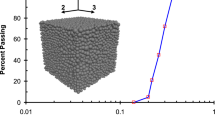Abstract
It would be convenient to have a model, albeit approximate, of particle-laden materials (suspensions) that would not need large amounts of computing and/or experimentation to implement for design purposes. There are now adequate models of the pure matrix fluid behaviour, but there are no such models for suspensions with large particles (non-colloidal suspensions). One of the obstacles has been the single-minded devotion to shearing motions of suspensions; experience with the matrix modelling has shown that it is not possible to formulate widely usable models if only shear is considered. Here some new results of axially symmetric elongational tests on suspensions are compared with shearing data. Some suggestions for modelling these and other observations based on using strain rate and strain in a modified Reiner-Rivlin constitutive equation are presented. The model generally works quite well, but it does not predict the positive storage modulus seen in small and medium amplitude oscillatory shear flows.











Similar content being viewed by others
References
Batchelor GK, Green JT (1972) Determination of bulk stress in a suspension of spherical particles to order c2. J Fluid Mech 56:401–427
Dai SC, Tanner RI (2017) Elongational flows of some non-colloidal suspensions. Rheol Acta 56:63–71
Dai SC, Bertevas E, Qi FZ, Tanner RI (2013) Viscometric functions for noncolloidal sphere suspensions with Newtonian matrices. J Rheol 57(2):493–510
Dbouk T, Lobry L, Lemaire E (2013) Normal stresses in concentrated non-Brownian suspensions. J Fluid Mech 715:239–272
Denn MM, Morris JF (2014) Rheology of non-Brownian suspensions. Ann Rev Chem Biomol Eng 5:203–228
Gadala-Maria F, Acrivos A (1980) Shear-induced structure in a concentrated suspension of solid spheres. J Rheol 24:789–814
Hohenemser K, Prager W (1932) Über die Ansätze der Mechanik isotroper Kontinua. Z Angew Math Mech 12:216–226
Kolli VG, Pollauf EJ, Gadala-Maria F (2002) Transient normal stress response in a concentrated suspension of spherical particles. J Rheol 46:321–334
Moon JY, Lee SJ, Ahn KH, Lee SJ (2016) Filament thinning of silicon oil/PMMA suspensions under extensional flow. Rheol Acta 54:708–714
Narumi T, See H, Honma Y (2002) Transient response of concentrated suspensions after shear reversal. J Rheol 46:295–305
Park HO, Bricker JM, Roy MJ, Butler JE (2011) Rheology of oscillating suspensions of noncolloidal spheres at small and large accumulated strains. Phys Fluids 23:013302
Phan-Thien N (1995) Constitutive equation for concentrated suspensions in Newtonian fluids. J Rheol 39:679–695
Phan-Thien N, Fan X-J, Khoo BC (1999) A new constitutive model for monodispersed suspensions of spheres at high concentrations. Rheol Acta 38:297–304
Reiner M (1945) A mathematical theory of dilatancy. Amer J Math 67:350–362
Rivlin RS (1948) The hydrodynamics of non-Newtonian fluids I. Proc R Soc London (A) 193:260–281
Sami S (1996) Stokesian dynamics simulation of Brownian suspensions in extensional flow. M.S.Thesis, Calif. Inst.of Technology., Pasadena
Seto R, Giusteri GG, Martiniello A (2017) Microstructure and thickening of dense suspensions under extensional and shear flows, To appear in J Fluid Mech Rapids (arXiv:1706.01745)
Shaw MT, Liu ZHZ (2006) Single-point determination of nonlinear rheological data from parallel-plate torsional flow. Appl Rheol 16:70–79
Stickel JJ, Phillips RT, Powell RL (2007) Application of a constitutive model for particulate suspensions: time-dependent viscometric flows. J Rheol 51:1271–1302
Sumita I, Manga M (2008) Suspension rheology under oscillatory shear and its geophysical implications. Earth Planet Sci Lett 269:467–476
Tamaddon-Jahromi HR, Garduño IE, Lὁpez-Aguilar JE, Webster MF (2016) Predicting large experimental excess pressure drops for Boger fluids in contraction-expansion flow. J Non-Newtonian Fluid Mech 230:43–67
Tanner RI (2000) Engineering rheology, 2nd edn. Oxford University Press, Oxford
Tanner RI, Dai S (2016) Particle roughness and rheology in noncolloidal suspensions. J Rheol 60(4):809–818
Vazquez-Quesada A, Tanner RI, Ellero M (2016) Shear thinning of non-colloidal suspensions. Phys Rev Letters 117: Art No.108001
Vazquez-Quesada A, Mahmud A, Dai S-C, Ellero M, Tanner RI (2017) Investigating the causes of shear-thinning in non-colloidal suspensions: experiments and simulations. JNNFM 248:1–7
Acknowledgements
We thank the University of Sydney for providing scholarship support for Arif Mahmud.
Author information
Authors and Affiliations
Corresponding author
Appendix. Conversion from torque to shear viscosity
Appendix. Conversion from torque to shear viscosity
In parallel plate viscometry, one has that the torque M on the plates is
where η is the viscosity, R is the plate radius, and \( \dot{\gamma} \) is the local shear rate.
We suppose that the shear rate at the rim is constant (\( \dot{\gamma} \) o) and that the shear strain at the rim is γ o. One has
Changing variables in Eq. 18 using 19, one has
where we assume the viscosity is a function of the local shear strain—the local shear rate is constant in time and the viscosity is assumed to be independent of the rate. Since most of the torque comes from the larger radius region, this does not lead to large errors (Shaw and Liu 2006).
Differentiating 20 with respect to γ o, we find
or
If we denote the Newtonian result for the torque when the viscosity is constant (η o) as M o, so that
we find
From the Gadala-Maria and Acrivos (1980) work, we have approximately, in the range 0 < γ < 3.5, the fitted result for the 50% suspension shown in Fig. 2.
Hence, one can find the value of the steady-state viscosity using Eq. 24 as a function of strain.
Table 4 shows this result and also the value of the Hencky strain (ε H) corresponding to the shear strain (γ o ) where one has
The final column in Table 4 subtracts the ‘unwinding’ period (\( \dot{\gamma t\sim }0.5,\mathrm{equivalent} \mathrm{to} \) ε H = 0.247) after shear reversal from the total strain.
In a similar way, one can analyse the results of Gadala-Maria and Acrivos (1980) for the 30 and 40% suspensions. The resulting correction factors which enable us to estimate the steady-state elongational viscosity are given in Fig. 7.
Rights and permissions
About this article
Cite this article
Mahmud, A., Dai, S. & Tanner, R.I. A quest for a model of non-colloidal suspensions with Newtonian matrices. Rheol Acta 57, 29–41 (2018). https://doi.org/10.1007/s00397-017-1052-x
Received:
Revised:
Accepted:
Published:
Issue Date:
DOI: https://doi.org/10.1007/s00397-017-1052-x




